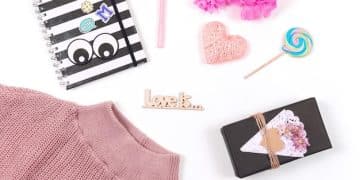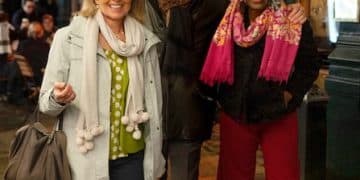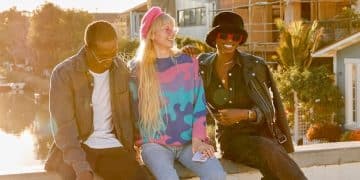DIY Fashion Hacks: Transform Old Clothes into Trendy Outfits
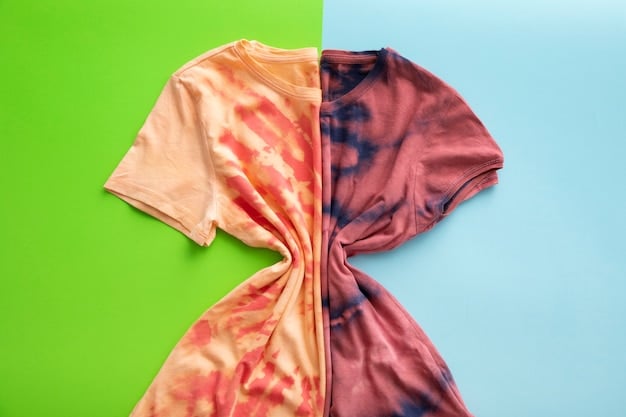
DIY Fashion offers creative and budget-friendly ways to transform your old clothes into trendy new outfits with simple hacks, reducing waste and refreshing your wardrobe.
Discover the magic of DIY fashion: transform old clothes into trendy new outfits with these simple hacks. It’s an affordable and sustainable way to refresh your wardrobe.
Why Embrace DIY Fashion and Upcycling?
DIY fashion and upcycling offer a unique blend of style, sustainability, and savings. By breathing new life into old clothes, you’re not just creating something fashionable; you’re also making a conscious choice to reduce waste and express your individuality.
Let’s explore the core benefits of diving into the world of DIY fashion:
Cost Savings
One of the most appealing aspects of DIY fashion is the potential for significant cost savings. Instead of constantly buying new clothes, you can repurpose what you already have, minimizing the need for expensive retail purchases.
Environmental Impact
The fashion industry is a significant polluter. Upcycling helps reduce textile waste and the demand for new resources. By participating in DIY fashion, you contribute to a more sustainable and eco-friendly lifestyle.
- Reduces landfill waste.
- Lowers the carbon footprint associated with new clothing production.
- Conserves water and energy.
Unleash Creativity
DIY fashion allows you to express your creativity and develop your unique style. You can combine different pieces, experiment with designs, and tailor clothes to fit your personal preferences.
Transforming old clothes into new outfits isn’t just about saving money and helping the environment; it’s about expressing your unique style and making a statement. So, let’s dive into some simple hacks to get you started.
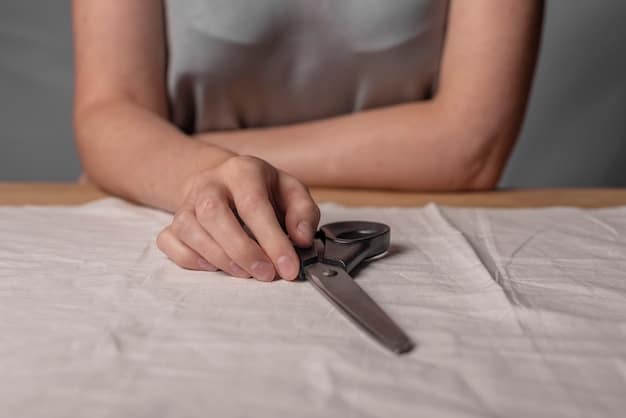
Easy Transformation Hacks for Beginners
Not sure where to start? These easy transformation hacks are perfect for beginners. They require minimal sewing skills and can make a big impact on your wardrobe.
Here are some straightforward ways to give your old clothes a fresh look:
T-Shirt Transformations
Old T-shirts are incredibly versatile. You can cut them into tank tops, crop tops, or even create stylish tote bags.
Denim Upgrades
Transform old jeans into shorts, skirts, or patched denim jackets. Adding embroidery or fabric paint can give them a unique touch.
- Fray the hems of jeans for a trendy, distressed look.
- Add patches with fun designs to cover up holes or simply add flair.
- Bleach or dye denim for a custom color.
Dress to Top
Transform an outdated dress into a matching set perfect for any occasion.
These hacks are designed to be easy and fun, making them ideal starting points for your DIY fashion journey. As you gain confidence, you can move on to more complex projects.
Intermediate Sewing Projects for Upcycling Clothes
For those with some sewing experience, a few intermediate projects can significantly elevate your upcycling game. These projects require slightly more skill but offer substantial style returns.
Here are some intermediate sewing projects for upcycling clothes:
Convert Button-Down Shirts into Dresses or Skirts
Button-down shirts can be deconstructed and reassembled into stylish dresses or skirts. This project involves basic sewing skills but results in a high-fashion piece.
Patchwork Projects
Use fabric scraps from old clothes to create patchwork jackets, skirts, or even home décor items. This is a great way to use up small pieces of fabric and create unique, colorful designs.
- Create a patchwork quilt from old T-shirts.
- Design a patchwork tote bag for a fun and practical accessory.
- Sew a patchwork skirt using various denim scraps.
Adding Embellishments and Trims
Adding embellishments like beads, sequins, or lace trims can transform a simple garment into something special. Experiment with different textures and colors to create a personalized look.
These projects not only expand your sewing skills but also open up new possibilities for upcycling and creating unique fashion pieces.
Advanced DIY Fashion Techniques
For the seasoned DIY enthusiast, advanced techniques can take your upcycling skills to the next level. These projects require a strong understanding of sewing and design principles.
Here are some advanced DIY fashion techniques:
Pattern Making
Learn to create your own patterns using old clothes as a template. This allows you to replicate designs with different fabrics or customize existing patterns to fit your unique style.
Deconstructing and Reconstructing Garments
Take apart complex garments and reassemble them in entirely new ways. This technique requires a keen eye for design and a solid understanding of garment construction.

- Turn a suit jacket into a fitted corset.
- Transform several different shirts into a single, eye-catching dress.
- Create a completely new outfit from the scraps of old formal wear.
Custom Dyeing and Printing
Experiment with custom dyeing techniques, such as tie-dye, ombre, or batik, to add unique colors and patterns to your upcycled creations. You can also try fabric printing to create custom designs.
Mastering these advanced techniques will enable you to create truly unique and high-fashion pieces, pushing the boundaries of what’s possible with upcycling.
The Best Fabrics for Upcycling
Choosing the right fabrics is essential for successful upcycling projects. Some fabrics are more forgiving and easier to work with than others. Understanding fabric properties can make your DIY journey smoother and more rewarding.
Here are some tips about the best fabrics to use for upcycling:
Denim – The Go-To Fabric
Denim is durable, versatile, and easy to work with. It can be transformed into a variety of items, from shorts and skirts to jackets and bags. Its rugged texture adds character to any project.
Cotton – Soft and Adaptable
Cotton is soft, breathable, and easy to dye or print on. It’s perfect for creating comfortable clothing items like dresses, tops, and skirts.
- Use cotton T-shirts for making tote bags.
- Repurpose cotton dresses into stylish skirts.
- Create patchwork designs with cotton scraps.
Wool – Warm and Stylish
Wool is warm, durable, and can be felted or knitted into new items. It’s ideal for creating cozy winter accessories like scarves, hats, and gloves.
By selecting the right fabrics for your projects, you can ensure that your upcycled creations are not only stylish but also durable and comfortable.
Maintaining and Caring for Your Upcycled Creations
Proper care is essential to prolong the life of your upcycled creations. Since these items are made from repurposed materials, they may require special attention to maintain their quality and appearance. Proper care makes upcycled items last longer.
Here’s a guide on how to take care of your upcycle projects:
Washing Tips
Always check the care labels on the original garments before washing your upcycled items. If the labels are missing or unclear, it’s best to hand wash them or use a gentle machine cycle with cold water.
Drying Techniques
Avoid using a dryer, as high heat can damage the fabric and cause shrinkage. Instead, air dry your upcycled items on a clothesline or drying rack.
- Lay delicate items flat to prevent stretching.
- Turn dark-colored items inside out to prevent fading.
- Avoid direct sunlight to prevent color damage.
Storage Solutions
Store your upcycled creations in a cool, dry place away from direct sunlight. Use padded hangers to prevent stretching or damage to delicate items.
By following these maintenance tips, you can ensure that your upcycled creations remain stylish and wearable for years to come.
| Key Point | Brief Description |
|---|---|
| ♻️ Environmental Benefits | Upcycling reduces textile waste and lowers carbon footprint. |
| 💰 Cost Savings | Repurpose old clothes instead of buying new ones. |
| 🧵 Beginner Hacks | Easy transformations like T-shirt and denim upgrades. |
| 🧽 Maintenance | Gentle washing, air drying, and proper storage help prolong lifespan. |
Frequently Asked Questions (FAQ)
▼
DIY fashion involves transforming old clothes into new, trendy outfits. Upcycling specifically focuses on reusing materials to create higher-value products, reducing waste and promoting sustainability.
▼
Beginner-friendly projects include cutting old T-shirts into tank tops, turning jeans into shorts by fraying the hems, and adding patches to denim jackets for a unique touch.
▼
DIY fashion reduces textile waste in landfills, lowering the carbon footprint associated with new clothing production. It also conserves water and energy by decreasing the demand for new resources.
▼
Denim, cotton, and wool are excellent choices for upcycling due to their durability and versatility. Denim can be easily transformed, cotton is soft and adaptable, and wool is perfect for warm accessories.
▼
Check the care labels on original garments, hand wash or use a gentle machine cycle with cold water. Avoid using a dryer, and air dry on a clothesline. Store in a cool, dry place away from sunlight.
Conclusion
By embracing DIY fashion and upcycling, you can transform your wardrobe into a collection of unique, stylish, and sustainable pieces. Whether you’re a beginner or an advanced sewing enthusiast, there are countless ways to breathe new life into old clothes and express your personal style while helping the environment.
